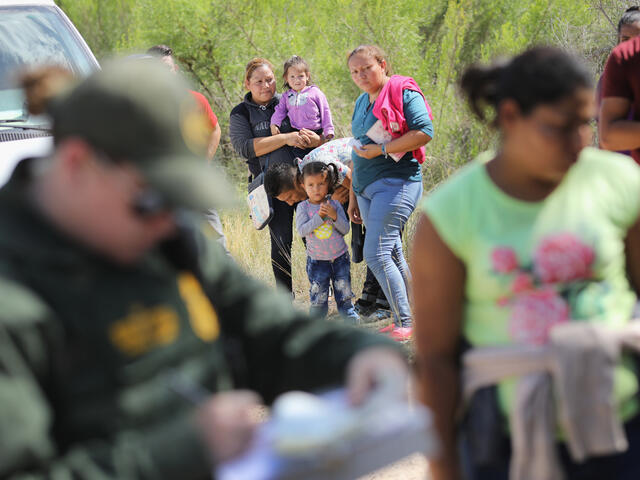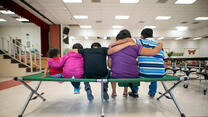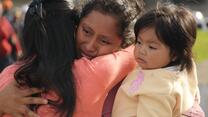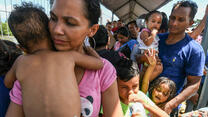
As caravans of Central American survivors of violence and abuse make their way to the United States border, here’s what you need to know about the situation.
What is the so-called migrant caravan? Why are asylum seekers traveling to the U.S. border?
Families escaping gang violence and persecution in Central America have undertaken a dangerous journey to seek safety in the U.S.
Since 2014, children and families have fled from rampant gang violence, including the recruitment of children and other forms of persecution perpetrated in Central America, including widespread violence against women.
Contrary to the Administration's claims, and based on the International Rescue Committee's experience in the region, the fears of persecution among those fleeing Central America are very real: Current levels of violence in the “Northern Triangle” region (El Salvador, Honduras, and Guatemala) are akin to those in the deadliest war zones around the world and continue to increase.
People fleeing their homes in El Salvador, Honduras and Guatemala often seek safety elsewhere within their countries, to no avail. Families embark on the journey to the U.S. because they are absolutely desperate, for such trips are fraught with danger— including shocking levels of rape and sexual violence along the route.
Many have credible asylum claims and the legal right to have their cases heard without being criminalized or, in the case of families, without having their children taken from them.
How is the U.S. responding to the caravan?
On Dec. 20 2018, the U.S. administration issued a new policy that will force people seeking asylum at the southern border to wait in Mexico while their claims are processed. The IRC is concerned that thousands of asylum seekers will now be in legal and physical jeopardy, and the decision could result in the creation of ad hoc refugee camps along the border in Mexico.
“[The] attack on asylum is yet another ill-conceived and constitutionally suspect action by the Administration that will undoubtedly endanger the lives of thousands of children and families and spur unprecedented chaos at the nation’s southern border,” said IRC senior director of refugee resettlement and asylum policy and advocacy Jenn Piatt.
“We know that individuals will not stop fleeing until the root causes of violence are addressed, and military troops or scare-tactics will not dissuade them, because currently there is no place scarier than their homes,” said Meghan Lopez who leads the IRC’s work in El Salvador.
Why don’t families enter the U.S. “legally”?
Crossing an international border to seek asylum is legal. International refugee law—which the U.S. helped create in the wake of World War II—recognizes the reality that refugees often aren’t in a position to follow regular procedures.
For that reason, the 1951 Refugee Convention prohibits states from penalizing asylum seekers based on their manner of entry. Moreover, several human rights organizations have documented systemic turn-backs at official U.S. ports of entry. In other words, even when asylum seekers have made their way to an official U.S. border crossing and asked for asylum, officials have turned them back into Mexico, in violation of both U.S. treaty obligations and U.S. law.
"While the administration is saying people should come here legally and follow a legal process, it's making it impossible to do so," said the IRC's director of immigration, Olga Byrne. "The members of the Central American caravan have been trying to follow a legal process. Many of them have arrived in Tijuana, but they have been denied access to any U.S. official.
Why was the U.S. separating immigrant families?
In early April 2018, the U.S. government formally introduced a “zero-tolerance” policy to prosecute all individuals apprehended between official U.S. ports of entry, including asylum seekers, in direct violation of U.S. international treaty obligations. When families were apprehended crossing the border outside an official port of entry, parents were sent to federal prison and their children were placed in government custody at separate detention facilities. This practice resulted in a de facto family separation policy. Nearly 3,000 children were separated from their parents at the U.S.-Mexico border.
How many families have been reunited?
The U.S. federal courts gave the Trump administration until July 26, 2018 to reunify these children with their parents. As of Sep. 20, 2018 just over 2,000 children had been reunited with their parents.
The U.S. administration signed an executive order on June 20, 2018 that proposed detaining children and their families for the length of their proceedings—which can often take many months or over a year—despite legal obligations to release children promptly under U.S. law.
Furthermore, the executive order continued to criminalize asylum seekers, in a break with international law. It separated family members where there isn't a "legal parent-child” relationship—with a lack of clarity of how this will be established.
What happened to the children?
Children were placed in government custody, with the goal of releasing them to family sponsors or, for certain younger children, placing them in foster care pending the decisions of their immigration court cases. Child detention centers are ill-equipped to handle young children and the broad range of ages resulting from family separations. There has been no clear procedure for parents who have been detained or deported to follow to track their children or find out how they will be reunified.
The IRC is very concerned about the welfare of children who were separated from their families and, in particular, about the psychological impact separation has on children. Toxic stress from displacement and violence can stunt cognitive development and hinder a child’s ability to learn as well as predispose them to violent and aggressive behavior.

How is the IRC helping children fleeing from Central America?
The IRC is helping facilitate family reunification as well as connecting reunited parents and children with critical legal services and psychosocial support and other basic needs.
We will provide a range of services to asylum-seeking families through our 27 offices across the United States. These services will be provided in two general areas:
- Emergency assistance, which may include temporary housing, access to emergency medical services, access to communications, transportation, cash assistance, and other basic needs.
- Case management support such as providing families with knowledge on their legal rights, mental health and social integration assistance, job readiness services, and limited legal services in addition to referrals for more complex legal needs.
In addition, we have been assisting children from Central America who have come to the U.S. to seek protection on their own, often with the intention of reuniting with family members residing in the U.S. Our work includes:
- basic orientation for children and their sponsors on their rights;
- information, training, and guidance for sponsors on issues ranging from education to child-welfare laws;
- referrals to legal services organizations and legal providers to help with asylum claims;
- home visits with foster parents to ensure the safety of minors.
Before the U.S. government ended the Central American Minors Resettlement Program in November 2017, the IRC also assisted families in the U.S. to apply for refugee status for their children in Central America, preventing the need for them to take the dangerous journey on their own.
How is the IRC helping in Central America?
The IRC was one of the first international organizations to declare a humanitarian crisis in El Salvador. Every year, an estimated 200,000 to 300,000 Salvadorans flee their homes in search of safety.
Working closely with the Salvadoran government and other local organizations, we are providing lifesaving information services to people uprooted by violence as well as emergency cash relief and assistance to high-risk people seeking shelter and safety.
“The IRC calls on the Administration to follow a humanitarian approach to incoming asylum-seekers, not a blanket ban based on nationality or race,” said the IRC’s Vice President for U.S. programs Hans van de Weerd.
How can I help Central America families?
Help the IRC support separated children and families seeking asylum in the U.S. Donate now.
Educate family and friends on the facts of legal asylum by sharing this story on Facebook or Twitter.
Urge your Member of Congress to speak out against the administration’s Asylum Ban.



